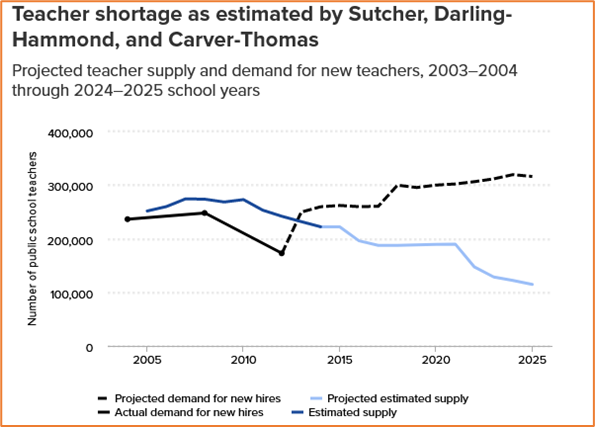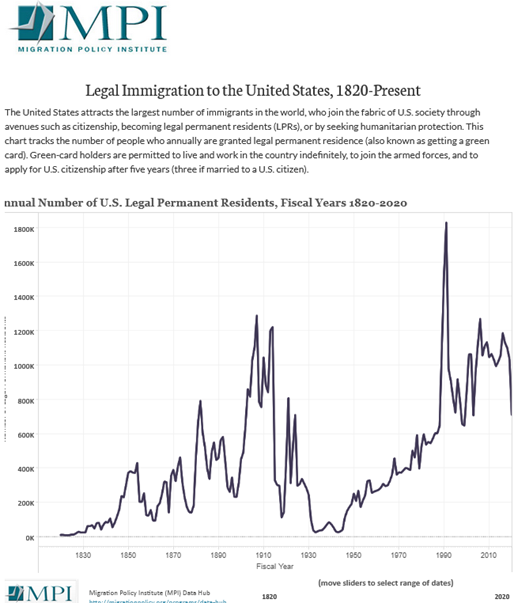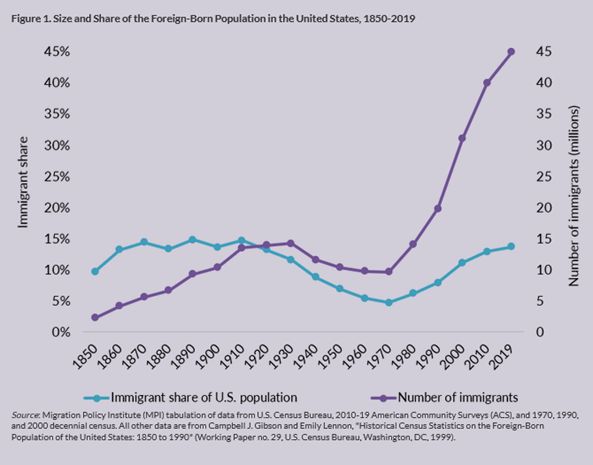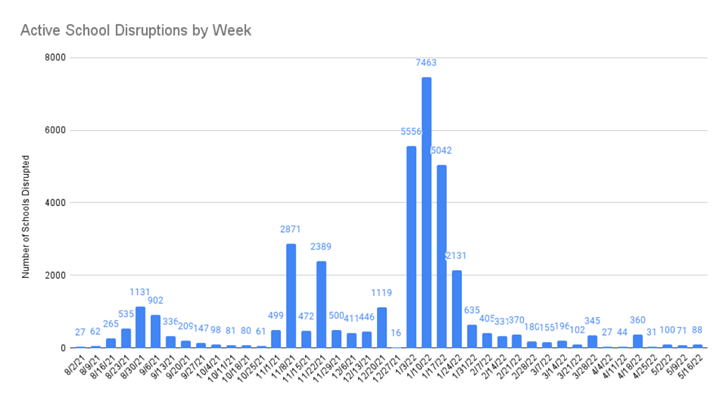“We cannot solve our problems with the same thinking we used when we created them.” – Albert Einstein
This three-part series seeks to identify the problem to act on, rather than approach each challenge as isolated.
The Fall 2022 school year just started and already the teacher shortage is enormously evident. School districts nationwide are feeling the pinch of an unholy trinity of problems:
1) Up to thousands of classrooms without teachers in large districts,
2) mass attrition of students to alternatives, and
3) loss of student achievement coming off the pandemic.
Administrators, politicians, and union leaders seek the same remedies they have always sought. More money to throw at the problem is the common thread. It’s either for recruitment from foreign nations, hired tutoring services, proffered alternative settings, such as more charters or community schools being licensed, or relaxing of the rules of engagement, such as teaching certificates for any veteran, fore-shortened certificates right out of high school, or providing the State’s own National Guard as teachers.
Yet, if the problem that is attempting to be solved is not the problem, it won’t be solved. It will get worse.
First, let’s take the teacher shortage honestly, while remembering that it is not the only problem in the overall scene. This is one of the tricks of true data analysis. You must look all around the problems, at the supply or decision chain leading up to the problems from every direction, at the difference made when levering any one part of the problem up or down, at the outside trends far afield leading up to the problem. Most of all, at the problem to find the truth of it, past any common thinking.
The teacher shortage is not necessarily new, the pandemic just made it much worse. In 2019, the Economic Policy Institute cited, “The teacher shortage is real, large and growing, and worse than we thought. When indicators of teacher quality (certification, relevant training, experience, etc.) are taken into account, the shortage is even more acute than currently estimated, with high-poverty schools suffering the most from the shortage of credentialed teachers.”1

The Salary Issue
More money over decades in increasing pay has not resulted in anywhere near the numbers needed of teachers being attracted into the industry. A belief that teachers are poorly paid, perpetuated ad nauseam by media and the entire culture of K-12 education, did have an original purpose. It was unseemly that the public should know teachers had decent pay, exceptional benefits, great pensions, and the right to retire early in comparison with the private sector taxpayer. Other than governments, there are very few traditional pension programs2 left in America. All of them are with very large companies and the biggest globally are not even American.3
Most American’s do not have additional money over their salary put away into future retirement money in the same way teachers do and must take from their own salaries to put into 401K plans and other assets to provide for retirement since social security payments will hardly do for most people.4
99.9% of all businesses in America are small business, below 1,000 employees, with no pensions and the majority without even 401K plans or even healthcare.5 Only 31% of small for profit or not-for-profit businesses with less than 50 employees offer healthcare plans.6
Here’s the kicker, the U.S. Bureau of Labor Statistics indicates that 46.45% of all business is under 50 employees in America.7 Based on employment statistics, that’s 73.5 million Americans, 50.9 million of which do not have healthcare plans offered by their employers yet work full time. Since only 10% of all businesses are over 1,000 employees, the other 69 million employed people working for businesses between 50 and 999 employees probably have a high number without healthcare plans as well. It’s a cinch that those without healthcare also do not have pensions, and these numbers could today be even amongst the businesses above 1,000 employees.8
Only working for government entities, which includes most of the K-12 education industry, guarantees such novelties as great healthcare and pensions.
Granted a cost-of-living increase makes sense for teachers right now, especially with run-away inflation. Yet, the price of healthcare and pension set-asides is a huge extra compensation rarely talked about. The cost of healthcare plans can run upwards of $800 a month with annual deductibles upwards of $10,000 for just two adults in the family, no children. Paying for this independently is a real problem for millions of Americans given the national average salary of only $53,924.11 At the average federal tax rate of 9.01%, that is down to $49,133 take-home pay. If you lived in a State with additional income tax, even less. After the national average of $438 a month on healthcare ($5,256 annually), you’d be left living on $43,877 or $3,656 a month.12 If you got ill and had to pay the high deductible of $10,000 or more, you may find you have to make many sacrifices.
Then there is the question of value for the dollar spent on teachers. The American Enterprise Institute found that public school teachers take home total compensation that's 52% higher than "fair market levels" for professionals with “similar cognitive abilities.”9 They unfortunately point out that the education profession doesn’t always get the top intellectuals with highest SAT or ACT scores from colleges. U.S. News & World Report similarly cited that “Prospective teachers are predominantly drawn from the bottom third of their college graduating class. Compared with those of college graduates with similar skills, teachers' average annual salaries of around $55,000 are about right.”9,10
It's important to acknowledge that we often hear teacher stories of “out of pocket expenses,” but other industries have the expenses of buying high-cost clothing for high-profile jobs, or equipment for things like construction because it’s expected. Heartfelt contributions from one’s own pocket also happen in other lines of work. The public relations optics of teaching is excellent in stories about buying extra crayons, but without context with other industries, it strains credulity. Professions that don’t need this sort of public relations myth attract talent and swarms of applicants because they demonstrate competence. The music and movie industries, doctors, etc. Since everyone goes to school, this observation about natural recruitment is a sure indictment of the K12 field that so few students would like to be any of the teachers they experienced for seven or more hours a day, 43 or more weeks, approximately 185 days a year for at least 12 years of their lives.
The question is, then, is the pay rate really the problem? Almost no person ever believes they make enough pay, in any industry.
The data is clear, it’s not the problem when the all-in compensation even at starter salaries sits at a national average of $100,000 including benefits and time off.
Additionally, the problem with the problem of the teaching shortage is that decades of culture shift has made teaching less than glamorous, thereby attracting a more mediocre crowd, with the added falsity that it pays poorly. The wise leader fixes the story from top to bottom. Uniform inspirational teaching, the right tech workflow – there is great work to be done.
The Retirement Issue
We’re in the great Resignation window of time where the Boomers are leaving or by now have mostly left. “The National Education Association, the country’s largest teacher’s union, recently conducted a survey that shows 55 percent of its members are thinking about leaving the profession earlier than they had originally planned.”13, 14, 15, 16
The fact is Boomer-aged educators are retiring at a rate of 10,000 a day and that accelerated in 2022.17,18 Yet it’s not just the Boomers leaving, it could additionally be from any age-group.
“Last month (Nov. 2021), there were 3.6 million more Americans who had left the labor force and said they didn't want a job compared with November 2019. A whopping 90% of them were over 55.”19
The truth is a large percentage of existing teachers are part of the Boomer age group. They are not being replaced, and they will continue to retire in large numbers. This means the openings will continue to grow even while the numbers of newly graduating teachers are continuing to shrink. The number of college students studying to become teachers in 2021 was just 70,000, less than 10% of need against retirements or growth needs of schools.
In Fall 2022, schools nationwide needed 1 million teachers and were able to get only a fraction of that, spiking the use of tutoring companies and causing all sorts of desperate measures already mentioned.
It is true that the generation after the Boomers, Gen-X are not as large of a population, but recruitment from Millennials and Gen-Z could more than make up for that.
Baby Boomers (Born 1946 to 1964) = 74,102,309
Generation X (Born 1965 to 1976) = 49,151,059
Millennials (Born 1977 to 1995) = 83,545,955
Generation Z (Born 1996 to Present) = 86,391,289 23
The question is, why are the large populations of Millennials and Gen-Z not in a replacement and growth pattern of becoming teachers?
This clue is in the first paragraph of this section – the field itself has lost considerable luster. The generations behind Gen-X are large but are just not into teaching the way they saw it being done for them with the one-to-many teaching and learning paradigm. The pandemic threw a monkey wrench into that as well.
The wise Principal already knows that the stressed-out, overburdened-with-reporting, testy-about-technology, disoriented with classroom distractions, and generally nullified-by-design-into-ineffectiveness teacher is not inspiring in the proper orders of magnitude to fill the ranks. They know why the great resignation is underway. They know why “teaching is so hard.” They just aren’t necessarily making it easier by any meaningful leaps in difference. Yet the clues are everywhere.
The great resignation is not the problem with the teacher shortage, it’s a symptom of something else.
A Changing Student Body Issue
Prior to the pandemic, total U.S. student population was cited at just over 56 million students with 3.3 million teachers serving those students. This does not include numbers for teachers of the population of homeschoolers, which ballooned from 6 million to over 9.3 million from 2019-Fall 2021. Nor does it include the teacher population in private schools which serve 5.4 million students and first gained great ground in the pandemic and then lost ground to homeschoolers or back to public schools in late 2021 and 2022. No one has any accounting for the millions of immigrant children in the last couple of years increasing the burden on schools with no corollary in increases in teachers.
In any case, the Federal citations do not seem to any longer include homeschooling students, particularly not from States that do not track “off-grid” students.
All this is to say, that if traditional schools and districts were attempting to keep at least the same baseline as prior years in numbers of teachers, they have lost enough students that you would think that they could do with a few less – but no. Even if you subtract the additional homeschoolers they’ve lost while adding back in a small percentage of private school students gained, you must add back in many new immigrants. It’s essentially a wash. The overall demand for teachers in public schools remain the same.
“The increase in the immigrant population between January 2020, before Covid-19 hit, and January 2022 was nearly 2.2 million, or 1.1 million a year, much more than the 770,000 average annual increase in the decade before the pandemic…. As a share of the total population, immigrants were 14.2 percent — the highest percentage in 112 years.”20
“More than 1 in 4 (26 percent), or approximately 18 million, U.S. children lived with at least one immigrant parent in 2018.”22 These numbers grew post the pandemic in 2021 and 2022. Yet, our country has historically seen much higher levels of immigration, but in times when multi-culturalism was actively discouraged and assimilation into a normed culture was encouraged. America’s founders implemented a cultural norming and single language to create an internally strong nation where commonalities would grease the wheels of growth and secure a uniform loyalty to a nation that had only just been born and was at risk on the international stage.
Schools have historically been normed-culture factories, and you can find early architects of the bureaucratic design particularly espousing the grand social normalizing, especially with the subject requirements. We live now, however, in a time when multi-culturalism is flying in the face of anything being normed at all.
When a school tries to be the “new norm” with progressive value leadership rather than a no-norm and just a place of basic studies, the issue in this time is that it fails in its one-safe-place-for-all construct. It loses students, gets into legal battles, and generally devolves into chaos. It could be argued that it is impossible to lead with a singular rule, multi-culturalism, when that singular view is itself anything but singular. It is ironic, unaligned, confusing, and worst of all tends to favor anything but the culture of the past which makes it decisively not multi-cultural. As one concrete example, there are cultural differences with respect to time. Some cultures are view time as more elastic, and upon arrival to an appointment like a class, expect a certain interval of socializing. This can greatly disrupt school learning. There are many other differences that play havoc with the way schools’ structure, program, and execute learning, all well beyond ideology alone. Leaders have already been lamenting that increasingly large numbers of students require Individual Education Plans (IEPs), putting pressure on the entire system. This is the true crisis of the changing student body. Some leaders might argue that ineffective teaching is part of the increase in teachers identifying more students for IEPs.
One absolute truth is that a single source with a single structure in a time of rapidly changing society, trying to maintain its old structure while letting its rules shift, will alienate some or all. This forces the development of increasing learning alternatives to satisfy the promotion of individual culture. It is, after all, the founding principal of private religious schools of any kind. It also possibly forces personally incongruous views be held and propagated by teachers who would just rather not and so they quit.
The changing student body, then, is a large topic. It could influence schools and the act of teaching itself and probably should – but at a cost of schools trying to match culture for some and potentially alienating others because of one rather insidious reality. Humans are not good at holding two truths equally and tend to pick one to give more support to. If the one they chose is fashionably new, it will alienate some of your parents and students. While the percentage of new immigrant children is growing at roughly 3% of the student population annually, it does add up. It brings with it ever-increasing new cultural demands from literally hundreds of different nations. There can be no mistaking the stark difference in schools in just a few years. Just since the start of the Biden Administration, 4.9 million illegal aliens have crossed the borders.20 Close to another million are granted legal immigration status currently per the Migration Policy Institute.23 For school leaders, these are very different times than the past 100 years.

An alternative source graphs Foreign-Born all the way back to 1850:

Our great-grandparents, our grandparents, our parents, and we, have not lived in such dramatic change before and quite frankly our capacity to realize we were even in a change and to innovate at scale has been sadly lacking.
The school schedule, structure of whole group manufacturing line, and the distribution of learning centered primarily on the teacher is inarguably, ancient. It’s also true that human teachers are important, but in the present age may be arrayed as a force differently to match new values and an on-demand structure. For certain, K12 schools have been one of the slowest sectors to adopt technology and use it to transition practice with advanced logistics and workflow providing automated human intersection to give individualized instruction efficiently. There is promise within the tech realm for providing enormously improved foreign language learning, even in the correct teaching moment fit to the certain culture.
Individualized online actions with retail commerce, shipping, health, travel, and even restaurant orders are an already an everyday experience.
The change in our population is not really the problem with the problem of teacher shortage then, but it may be contributive. It’s wise to view this population shift in all its dimensions, accompanied at the same time with significant culture and value shift being led by schools, and all of that with a backdrop of an even larger technological shift shared amongst all people today.
Could it be that the changing student body is just one of the other big changes leading to pressures on teaching? This would make it part of the problem but not the problem.
Other Issues indicating the teacher shortage is not the Problem
- 74% of teachers cite being overwhelmed or “burnt out” per the 2021 Learning Counsel national survey. Indications of responses in the currently open surveys of 2022 are indicating this is not getting better. Potentially this means there is something to inspect with the job itself having shifted recently and not been reengineered to fit new realities.
- Explored more in the last article of this series, student achievement nationwide is still on a downward trend and is now also woefully behind with massive learning loss from the pandemic years…which may never be over. Research cites that school closures for days, weeks at a time, remain high. Potentially this means there is something to inspect in the construct of how learning is done and the present culture, not just inside the present system, but outside. What’s working elsewhere despite physical presence of students on campus being inconsistent or required to be flexible?

Source: https://cai.burbio.com/school-opening-tracker/
- The consumer markets for any digital curriculum and discrete function Apps are more than double the spend of all schools put together. This indicates a shift in confidence to professional grade digital learning that is mostly teacher-less. What, specifically, is different in this new online learning paradigm than the early days of online courses or the pandemic days of replacing the school with teaching via Zoom? Something in the craft of digital curriculum perhaps?
- Indiscriminate tech adoptions by schools and districts fueled by the desires of teachers rather than a full mapping of curriculum needs and tools against a strategic viable curriculum plan has led to the fact that 67% of teachers cite having 100-500 digital resources in use. This “letting” is not really “leading” and has resulted in situations like an inability to gather meaningful data and more choosing to custom create than use professional grade commercial offerings. Schools and districts have then overlaid more reporting, contributing to teacher overwhelm. Why not inspect what teachers are doing with tech or not doing and implement more professional grade courseware along with digital workflow to reduce burdens?
Teachers are important, but their human capacities within a maelstrom of change are something to consider. The significance of the issues outlined here, one could hope, would all be pointing at figuring out a way to hire more teachers – but they clearly do not. The problem with education’s teacher shortage problem is not just more teachers and more expense – it is deeper than that.
The teacher shortage is not the problem.
Stay tuned for more about the Problem with the Problems:
Part 2: The Attrition Issue
Part 3: The Achievement Issue
References:
- The teacher shortage is real, large and growing, and worse than we thought, Economic Policy Institute, Emma Garcia and Elaine Weiss, March 26, 2019 https://www.epi.org/publication/the-teacher-shortage-is-real-large-and-growing-and-worse-than-we-thought-the-first-report-in-the-perfect-storm-in-the-teacher-labor-market-series/
- OPERS, Traditional Pension Plan. https://www.opers.org/members/traditional/index.shtml. The Traditional Pension Plan is a defined benefit plan that provides fixed, monthly lifetime retirement benefits. Your benefit is determined by a formula that rewards you for working longer – the more years you work, the bigger your monthly payment.
- Top 100 Largest Corporate Pension Rankings by Total Assets, SWFI, https://www.swfinstitute.org/fund-rankings/corporate-pension
- Pension Plans: Definition, Types, Benefits & Risks, Amelia Josephson, Aug 30, 2022, Smart Asset, https://smartasset.com/retirement/what-is-a-pension-plan
- The State of Small Business Now, U.S. Chamber of Commerce, Sept. 16, 2021 https://www.uschamber.com/small-business/state-of-small-business-now
- Percent of Private Sector Establishments That Offer Health Insurance to Employees, by Firm Size, KFF, 2020 https://www.kff.org/other/state-indicator/firms-offering-coverage-by- size/?currentTimeframe=0&sortModel=%7B%22colId%22:%22Location%22,%22sort%22:%22asc%22%7D
- March 03, 2017, U.S. Bureau of Labor Statistics, https://www.bls.gov/opub/ted/2017/establishments-with-fewer-than-50-workers-employed-60-percent-of-construction-workers-in-march-2016.htm
- United States Employed Persons, Aug. 2022 https://tradingeconomics.com/united-states/employed-persons
- Are Teachers Paid Too Much? How 4 Studies Answered 1 Big Question, Jordan Weissmann, Nov. 4, 2011, The Atlantic, https://www.theatlantic.com/business/archive/2011/11/are-teachers-paid-too-much-how-4-studies-answered-1-big-question/247872/
-“American public-school teachers are paid far more than their smarts are worth. That's the provocative conclusion of a new study from two high-profile conservative think tanks. Researchers from the Heritage Foundation and the American Enterprise Institute found that public school teachers take home total compensation that's 52% higher than "fair market levels" for professionals with similar cognitive abilities…
Public school teachers did pretty well by the hour. In 2005, they worked an average of 36.5 hours per week at an average wage of $34.06 an hour. That was better than 61% of the other occupations the researchers examined, including architects, psychologists, chemists, mechanical engineers, economists, and journalists (!). There were big variations by metro area, but teachers still generally beat out their peers. Raleigh, North Carolina, was the only metro area where public school teachers made less than the average white-collar worker. In Louisville, Kentucky, they made 79% more.”
-"Although teachers as a group score above the national average on intelligence tests, their scores fall below the average for other college graduates," the pair write. Teachers, they find, also score lower on their SAT and ACT. Finally, they break out data from the National Longitudinal Survey of Youth to analyze the effects of both education and IQ. When education is taken into account, teachers’ salaries are more than 12% lower than their peers. But when measured based on cognitive skills, the salary gap evaporates. Once you factor in benefits such as retiree healthcare and pensions, total teacher compensation starts to eclipse what others in their cohort make. To top it all off, teachers tend to take a pay cut when they move to other professions.”
10. Average Public School Teacher Is Paid Too Much, Andrew G. Biggs and Jason Richwine, Nov. 9, 2011, at 2:50 p.m., U.S. News & World Report, https://www.usnews.com/debate-club/are-teachers-overpaid/average-public-school-teacher-is-paid-too-much
“The average teacher working in a public school today receives total compensation roughly 52 percent higher than what he or she would receive in private-sector employment. In that sense, the teacher is, indeed, "overpaid."
Teachers may appear underpaid because they receive lower salaries than the typical college graduate. However, prospective teachers are predominantly drawn from the bottom third of their college graduating class. Compared with those of college graduates with similar skills, teachers' average annual salaries of around $55,000 are about right.
It is generous fringe benefits that push total teacher compensation far ahead of private-sector levels. A full-career teacher can receive guaranteed pension benefits four times those of a private-sector worker with a 401(k) plan. Moreover, most teachers also receive retiree health benefits worth hundreds of thousands of dollars over the course of retirement. Teachers also enjoy 185- to 195-day work years, compared with 260 days for typical private-sector workers. Total fringe benefits for teachers are equal to 101 percent of their salaries, versus just 44 percent for workers in large private firms.
On top of that, schoolteachers are only half as likely to become unemployed as private-school teachers and workers in similar white-collar occupations.
For example, when the Census Bureau asks Americans how many hours they work per week, teachers give virtually the same answer as non-teachers. And even if we assumed that non-teachers suffered zero out-of-pocket expenses, the "hundreds of dollars" spent by teachers on classroom supplies would have little effect on our analysis. After all, average teacher salaries and benefits total well over $100,000.
There is no reasonable means of adjusting the data or altering the assumptions to make the teacher compensation premium disappear. Recognizing that the average public school teacher receives excessive compensation is the first step toward meaningful pay reform.”
11. What's the Average Salary in the U.S.? (Demographic Data), June 30, 2022 https://www.indeed.com/career-advice/pay-salary/average-salary-in-us
12. How Much Does Health Insurance Cost Per Month? Health Markets, 2022 https://www.healthmarkets.com/content/health-insurance-cost-per-month pay
13. Teachers across the country are quitting and changing careers due to staff shortages, pandemic related stress and low pay, Fallon Silcox, March 9, 2022 https://www.baynews9.com/fl/tampa/news/2022/03/09/great-teacher-resignation
14. Retirement Trends Of Baby Boomers, Forbes Finance Council, David Haass, Sept. 3, 2019, https://www.forbes.com/sites/forbesfinancecouncil/2019/09/03/retirement-trends-of-baby-boomers/?sh=6c019b947378
15. The pace of Boomer retirements has accelerated in the past year, Nov. 9, 2020, Pew Research Center, https://www.pewresearch.org/fact-tank/2020/11/09/the-pace-of-boomer-retirements-has-accelerated-in-the-past-year/
16. The data that shows Boomers are to blame for the labor shortage, Allison Morrow, Sat December 18, 2021, https://www.cnn.com/2021/12/18/business/labor-shortage-boomers-millennials-nightcap/index.html
17. Foreign-Born Population Hits Record 46.6 Million in January 2022, Census Bureau data shows the number of immigrants in the U.S. rebounded dramatically after declining through mid-2020, Steven A. Camarota and Karen Zeigler on February 23, 2022, https://cis.org/Camarota/ForeignBorn-Population-Hits-Record-466-Million-January-2022
18. Immigrant Children, December 28, 2018, https://www.childtrends.org/indicators/immigrant-children From 1994 to 2017, the percentage of children who are immigrant children, either first- or second- generation, increased by 51 percent, from 18 to 27 percent. In 1994, 12.2 million children were immigrants.
19. The State of America’s Children® 2021 -- Immigrant Children - 1 in 4 -- CHILDREN IN THE U.S.— APPROXIMATELY 18 MILLION—ARE CHILDREN OF IMMIGRANTS. https://www.childrensdefense.org/state-of-americas-children/soac-2021-immigrant-children/ “More than 1 in 4 (26 percent), or approximately 18 million, U.S. children lived with at least one immigrant parent in 2018.”
20. August 16, 2022, FAIR Analysis: 4.9 Million Illegal Aliens Have Crossed our Borders Since President Biden Took Office https://www.fairus.org/press-releases/border-security/fair-analysis-49-million-illegal-aliens-have-crossed-our-borders
21. Migration Policy Institute, https://www.migrationpolicy.org/programs/data-hub/charts/Annual-Number-of-US-Legal-Permanent-Residents
22. Frequently Requested Statistics on Immigrants and Immigration in the United States https://www.migrationpolicy.org/article/frequently-requested-statistics-immigrants-and-immigration-united-states-2020
23. How Large is Each Generation in the US? From Gen Z and Millennials to Gen X, Boomers, and Traditionalist, The Center for Generational Kinetics, https://genhq.com/large-generation-us/











